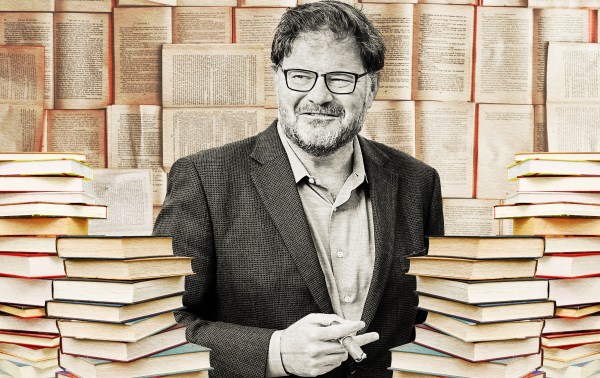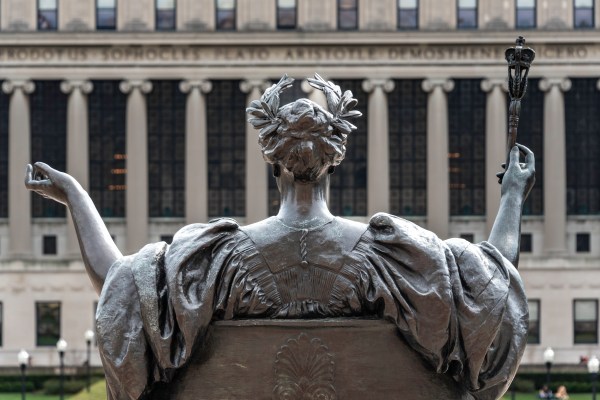In front of me sit five books from my bookshelf: Blindness by José Saramago, Invisible Man by Ralph Ellison, The Electric Kool-Aid Acid Test by Tom Wolfe, Crazy Horse and Custer by Stephen Ambrose, and All Quiet on the Western Front by Erich Maria Remarque. The books were published by Mariner, Vintage, Picador, Anchor Books, and Ballantine Books, respectively. Although the names of these publishers may not be immediately recognizable, a closer look reveals that they are all imprints of three major publishing houses: Penguin Random House (Vintage, Anchor, Ballantine), MacMillan (Picador), and HarperCollins (Mariner).
Simon & Schuster and Hachette Book Group round out what is commonly called the Big Five, a collection of book publishers that collectively controls around 80 percent of the book-publishing market. Chances are, if you purchase a book from Barnes & Noble, it was published by one of these five major companies. Indeed, of the 13 other books on one of my shelves, every single one was published by an imprint of one of the Big Five houses.
But the Big Five are not the only game in town. The Independent Book Publishers Association (IBPA) boasts around 3,600 members, and none of them (with the exception of Sourcebooks, of which Penguin Random House owns a 75 percent stake) is owned by one of the Big Five. About 40 percent of these members are self-published authors, which means somewhere around 2,160 are either standalone publishing houses or university presses.
In other words, despite the common narrative that the Big Five publishing houses rule the industry with an iron fist, there are certainly competitors for authors to choose from. And for a particular type of writer—especially authors who aren’t international bestsellers but nonetheless know how to build and satisfy an audience—corporate publishers, which are good at getting books into stores across the country but aren’t usually as good at outreach to specific readers, may actually do more harm than good.
Big publishers are, understandably, focused on their bottom line. “If you think about the purpose of a corporate publisher,” IBPA CEO Andrea Fleck-Nisbet told me, “their main purpose is to satisfy their investors.” The business model of a big corporate publisher mirrors that of a venture capital firm: They make big bets on a few books that they hope will sell millions of copies, ideally within the first few weeks of publication—the canonical example here is Prince Harry, who was reportedly paid a $20 million advance for his memoir—and assume, as Fleck-Nisbet said, that “everything else is going to lose money.”
This model is great for the big-name authors who earn six- or seven- or eight-figure advances, but midlist authors—an industry term for authors whose books are well-received but aren’t bestsellers—don’t fare nearly as well. There are many reasons why the big publishers stop promoting books written by midlist authors after the first few weeks of sales, but basically it comes down to a lack of resources: Because each of the Big Five houses publishes more than 1,000 books per year, they don’t tend to spend the necessary resources on the books they expect won’t make them any money. Jane Friedman, a Cincinnati-based author with over 25 years’ experience reporting on the publishing industry, told me that for smaller titles, “It’s like sink or swim for the author.”
Infinite Books, a new publisher launched last month by the American company O’Shaughnessy Ventures, seeks to operate with a different business model. Jimmy Soni, Infinite Books’ CEO, said that the publisher plans to treat “every single book as its own standalone business” and to “try over time to get it to profitability,” rather than push for record sales over a short time following publication. Soni explained that this approach was inspired by his experience with his own books, which, he said, “have earned out over time.”
Part of treating each book as its own standalone business is reimagining “every part of the [publishing] process,” according to Soni. One part that Infinite Books is rethinking is book contracts, which are typically formulaic and leave authors with a meager 15 percent or so of the royalties. By contrast, Infinite Books is focused on designing custom contracts for each author—for instance, authors who want to take a bet on their book’s sales may waive the advance altogether in return for a majority share of the royalties. “That’s a totally fair deal for us as a publisher,” Soni said, “and also puts the onus on us to make sure the book sells.”
But perhaps more important for midlist authors than having the option to sign bespoke contracts is the willingness of independent publishers to devote more resources to connecting authors and readers. Indeed, “the dirty secret” in publishing today, Fleck-Nisbet told me, “is that the marketing and the reaching [of] consumers, no matter who you are, is ultimately up to the author.” This is because, instead of selling directly to readers, traditional publishers are mostly focused on selling to retailers—a strategy that typically sold the most books in the decades during which the Big Five amassed their market power.
Friedman explained that this retail-focused bookselling model coincided with the onetime cultural dominance of large media outlets, and that the necessity of satisfying individual consumers’ book-buying preferences today mirrors the trajectory of the media landscape writ large. Once upon a time, she told me, reviewers in mainstream outlets such as The New York Times had outsize influence on which books readers bought, and large publishers would typically build relationships with institutional reviewers as a result. Today, she told me, in part because Amazon has almost infinitely expanded the pool of books available for purchase, readers are “not necessarily relying on the mainstream media” to recommend books to them; instead, “they’re looking at their peer group, they’re looking at influencers, they’re looking at people on social media.” In other words, as the mainstream media has declined in influence, big publishers have lost one of their main advantages. As a result, “it’s a little bit harder for the publisher to push the same buttons as before” to juice book sales—and authors are now expected to build their own following through social media, email newsletters, and other avenues.
The consensus among people I talked to for this story is that big publishers haven’t been able to keep up with the times, and authors have been worse off for it. (Representatives from each of the Big Five publishing houses did not return my request for comment.) As a result, this more social-media-heavy, influencer-dominated consumer marketing era has opened the door for enterprising startup publishing houses and self-publishers to establish devoted readerships. Friedman and I discussed the case of Brandon Sanderson, the fantasy author who began a Kickstarter campaign in 2022 to self-publish the four novels he had written during the pandemic. After just one month, he had raised nearly $42 million from 185,000 backers—the largest Kickstarter campaign in history—and delivered the books directly to readers who had contributed to the crowdfunded effort before letting his publisher have the paperback distribution rights. Sanderson is perhaps the most successful example of a growing type: “savvy authors,” as Friedman calls them, who are “using publishers to their own ends”—but not relying on companies to do (or not do) the important work of connecting with and satisfying their fans.
Indeed, many authors turn to alternative publishing platforms and perform these functions on their own. One such platform is Substack, where “authors have been serializing books . . . since the early days,” as Sophia Efthimiatou, head of publisher relations and events at Substack, told me via email. Efthimiatou said that “more and more writers are using Substack to share long-form work in installments and build dedicated, engaged readerships along the way.” (She did not provide specific numbers to bolster this claim.) Examples include Ted Gioia’s Music to Raise the Dead and Patti Smith’s The Melting.
“Unlike other self-publishing options,” Efthimiatou said, “Substack is a live, organic space where authors can gather their most engaged supporters and keep the conversation going well beyond publication day.”
Substack is certainly promising for nonfiction writers, but Friedman thinks the notion that the platform is disrupting the fiction publishing industry is “ridiculous.” “There’s very little audience on Substack for serialized fiction,” she told me, citing Wattpad—which was founded in 2006 and is generally understood as hosting fiction—as the online platform where serialized fiction authors find real success. Ross Douthat, the New York Times columnist, confirms that the audience on Substack for serialized fiction, at least in his experience, has been lackluster. Douthat’s book The Falcon’s Children, a fantasy novel that he has been serializing on the platform since September 2024 after established fantasy publishers “politely declined to publish it,” has received a “very kind” reception from its audience. But, he said, the book has attracted “a relatively small number” of paid subscribers. (When I told him that I am subscribed but have only read about 500 words of the first chapter, Douthat quipped, “Then you are probably a representative subscriber.”)
Of course, the other major benefit of using Substack—as with any self-publishing platform—is that the author retains total control over the project. This autonomy is what drove Philip Graham, author of nine books of fiction and nonfiction, to self-publish his latest book, What the Dead Can Say. Graham told me that the novel is “the central book” of his career, and it took over 30 years to write. Because it defined so much of Graham’s identity as an artist, he didn’t want anyone meddling in the creative process.
So Graham published the book himself. The physical version, which Graham and his wife distributed to Little Free Libraries across the country, is designed not to sell but to compel readers who pick up the book to continue reading for the sake of the story. To that end, the book has a barebones cover and omits Graham’s name; it also forgoes the usual author blurbs and the summary on the inside flap. This type of book “would be impossible to exist in the commercial world that we have in publishing,” Graham said. Meanwhile, Graham told me he keeps 94 percent of the revenue from the online version of the book, a rate that would be unheard of even with independent presses, let alone a big publishing house. The best part? He has “never had more fun publishing a book.”
Much of the commentary on book publishing presents an image of an industry in decline. The condemnations are many: publishers are selling out to unethical private-equity companies, Amazon retains a “death grip” on bookselling, nobody buys books anymore (that last bit, Friedman tells me, is a common misconception: While nonfiction book sales are down, “fiction has been doing phenomenally well”). And, given the large publishers’ tendency to pull resources from midlist authors to focus on their cash cows, it’s understandable for authors to be wary of the Big Five.
But today, we live in a brave new world of publishing, one in which the Big Five are no longer the only players in the game (their market dominance, according to some reporting, has been slipping in recent years). Indeed, after reporting this story, I’ve come to the conclusion that it may actually be better for authors to publish with independent publishers, or even on their own. Especially for midlist authors who have found limited success with traditional publishing—“an endangered species” in today’s world, as Douthat put it—independent publishing or self-publishing may be the way to go, assuming those authors know how to connect with their audience.
That last bit is a big assumption. Cultivating and maintaining a devoted readership requires time and attention, and many an author may recoil at the prospect of working to build a brand in addition to creating their art. (And it’s likely that more people will fail at this project than will succeed.) Additionally, authors who rely on their audience for their livelihood are at risk of falling victim to audience capture, whereby they become increasingly beholden to the wishes of their fans rather than guided by their own artistic vision. But like it or not, in our modern attention economy and influencer-obsessed culture, it seems that’s what it takes to make a good living selling books.
Of course, in the long run, whether books will be able to compete with other sources of information or entertainment, especially in the age of AI, is another question entirely. But that’s a story for another day.






Please note that we at The Dispatch hold ourselves, our work, and our commenters to a higher standard than other places on the internet. We welcome comments that foster genuine debate or discussion—including comments critical of us or our work—but responses that include ad hominem attacks on fellow Dispatch members or are intended to stoke fear and anger may be moderated.
With your membership, you only have the ability to comment on The Morning Dispatch articles. Consider upgrading to join the conversation everywhere.